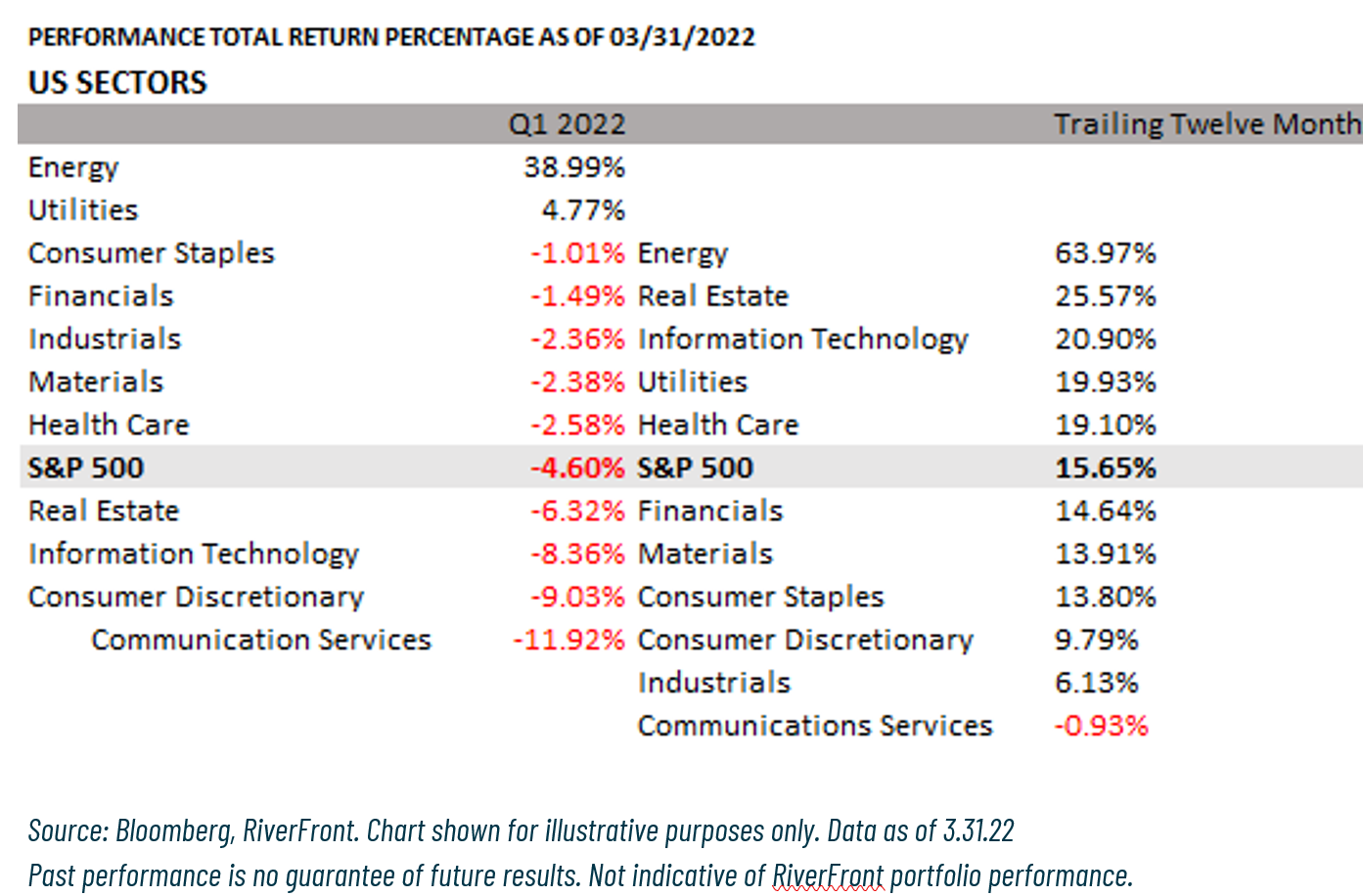Geopolitics Have Poured Gasoline on the Inflation Fire
There were three major geopolitical events in the first quarter:
- Rapid COVID-19 Recovery – increased demand for energy resources which drove up prices
- The Ukrainian/Russian War – reduced supply of oil and food and further complicated shipping routes
- Diplomatic Strain with China – slowed logistics in the South China Sea and created supplier uncertainty for companies
Unfavorable resolution of any of these three raise the risk of high inflation becoming structural. This could create low economic growth or even a recession coupled with high inflation – a phenomenon known as ‘stagflation’. Central bankers, governments and markets have a handful of tools at their disposal to try to avoid this. Since the different tools have different time lags to affect the economy, the process will look more like a feedback loop, with the different financial constituents interpreting each other’s actions and reacting in real time. This feedback loop is likely to lead to elevated uncertainty, hence the analogy in our 2022 Outlook of market volatility reminiscent of riding a mechanical bull.
Performance: A Closer Look

2022 started off with an abrupt shift in the market’s perception of inflation. Over the quarter, U.S. long term interest rates rose 1%, and international rates turned positive after remaining below zero for some time. This increase has yet to show signs of tamping down inflation, but it did produce the first quarter of negative equity returns since the beginning of the pandemic. Fixed income performed as poorly as equities,
which provided a challenging backdrop for investors who rely on bonds as a diversifier against negative equity returns. While a rally in equities at quarter-end helped, the S&P 500 (Large US Companies) lost -4.6%. The Bloomberg Aggregate bond index lost -5.9% as a direct result of the increase in rates. Developed International Markets (-6.5%) and Emerging Markets (-7%) performed poorly as concerns about Ukraine took center stage in the second half of the quarter. High yield bonds were negatively impacted both by interest rate increases and credit risk. Cash was the only haven in the broad asset classes we track.
Sector Returns Were a Function of Inflation and Rates

Looking under the hood at US sectors, we see that the only refuge for investors was the energy sector, which led both during the quarter and over the last twelve months. Utilities that have exposure to energy production also benefited. Staples were able to effectively pass on inflation to consumers, and other cyclically oriented sectors (Industrials, Financials, and Materials) were able to keep up with inflation better than growth-oriented sectors (Tech, Comm Services, Health Care and Discretionary). Similarly, Real Estate lost ground due to its reliance on low interest rates in order to finance projects. On a trailing twelve-month basis, Energy has now built a strong tactical lead over the other sectors. Returns are still positive for equity investors over the past year, except for Comm Services, which had several notable earnings misses.
As we move into Q2, there is concern that earnings will begin to slow down; only the Energy sector is currently seeing analyst earnings estimates accelerate (see chart, below). It is natural to see some level of slowdown in earnings revisions coming off a year like ’21, where the economic rebound was so sharp. However, we believe that earnings must continue to grow in order for stocks to finish the year higher. We believe that companies in cyclical sectors now have the wind at their back, and that technology companies will surprise investors with their earnings resiliency in Q2. We are more concerned about the earnings growth of Staples, Health Care and Utilities in this environment, due to rising input prices.

International Returns Also Related to Inflation, Rates, and Geopolitics
International Country Selection came down to two factors this quarter, in our view. Countries that are commodity producers (ex-Russia) performed remarkably better than those that weren’t. Latin America benefitted especially from its enviable position as a commodity supplier to China and the United States. Canada, Norway, and Australia similarly benefitted from rising commodity prices, while Europe struggled from Russian geopolitics, and Japan was harmed by the rise in energy costs.
Conclusion

The bottom line is that macro and geopolitical issues in the first quarter led directly to volatility and weakness in both stocks and bonds, which we believe makes getting a handle on possible inflation outcomes critical for the rest of 2022. In our upcoming Weekly View, we will flesh out the most likely scenarios, their implications for different asset classes, and how we are positioning portfolios.
Important Disclosure Information:
The comments above refer generally to financial markets and not RiverFront portfolios or any related performance. Opinions expressed are current as of the date shown and are subject to change. Past performance is not indicative of future results and diversification does not ensure a profit or protect against loss. All investments carry some level of risk, including loss of principal. An investment cannot be made directly in an index.
Information or data shown or used in this material was received from sources believed to be reliable, but accuracy is not guaranteed.
This report does not provide recipients with information or advice that is sufficient on which to base an investment decision. This report does not take into account the specific investment objectives, financial situation or need of any particular client and may not be suitable for all types of investors. Recipients should consider the contents of this report as a single factor in making an investment decision. Additional fundamental and other analyses would be required to make an investment decision about any individual security identified in this report.
Chartered Financial Analyst is a professional designation given by the CFA Institute (formerly AIMR) that measures the competence and integrity of financial analysts. Candidates are required to pass three levels of exams covering areas such as accounting, economics, ethics, money management and security analysis. Four years of investment/financial career experience are required before one can become a CFA charterholder. Enrollees in the program must hold a bachelor’s degree.
All charts shown for illustrative purposes only. Technical analysis is based on the study of historical price movements and past trend patterns. There are no assurances that movements or trends can or will be duplicated in the future.
Index Definitions
S&P 500 Indices shown in the chart on page 2 comprises those companies included in the S&P 500 that are classified as members of the applicable GICS® sector.
In a rising interest rate environment, the value of fixed-income securities generally declines.
Stocks represent partial ownership of a corporation. If the corporation does well, its value increases, and investors share in the appreciation. However, if it goes bankrupt, or performs poorly, investors can lose their entire initial investment (i.e., the stock price can go to zero).
Bonds represent a loan made by an investor to a corporation or government. As such, the investor gets a guaranteed interest rate for a specific period of time and expects to get their original investment back at the end of that time period, along with the interest earned. Investment risk is repayment of the principal (amount invested). In the event of a bankruptcy or other corporate disruption, bonds are senior to stocks. Investors should be aware of these differences prior to investing.
Investing in foreign companies poses additional risks since political and economic events unique to a country or region may affect those markets and their issuers. In addition to such general international risks, the portfolio may also be exposed to currency fluctuation risks and emerging markets risks as described further below.
Changes in the value of foreign currencies compared to the U.S. dollar may affect (positively or negatively) the value of the portfolio’s investments. Such currency movements may occur separately from, and/or in response to, events that do not otherwise affect the value of the security in the issuer’s home country. Also, the value of the portfolio may be influenced by currency exchange control regulations. The currencies of emerging market countries may experience significant declines against the U.S. dollar, and devaluation may occur subsequent to investments in these currencies by the portfolio.
Foreign investments, especially investments in emerging markets, can be riskier and more volatile than investments in the U.S. and are considered speculative and subject to heightened risks in addition to the general risks of investing in non-U.S. securities. Also, inflation and rapid fluctuations in inflation rates have had, and may continue to have, negative effects on the economies and securities markets of certain emerging market countries.
Technology and internet-related stocks, especially of smaller, less-seasoned companies, tend to be more volatile than the overall market.
Buying commodities allows for a source of diversification for those sophisticated persons who wish to add this asset class to their portfolios and who are prepared to assume the risks inherent in the commodities market. Any commodity purchase represents a transaction in a non-income-producing asset and is highly speculative. Therefore, commodities should not represent a significant portion of an individual’s portfolio.
RiverFront Investment Group, LLC (“RiverFront”), is a registered investment adviser with the Securities and Exchange Commission. Registration as an investment adviser does not imply any level of skill or expertise. Any discussion of specific securities is provided for informational purposes only and should not be deemed as investment advice or a recommendation to buy or sell any individual security mentioned. RiverFront is affiliated with Robert W. Baird & Co. Incorporated (“Baird”), member FINRA/SIPC, from its minority ownership interest in RiverFront. RiverFront is owned primarily by its employees through RiverFront Investment Holding Group, LLC, the holding company for RiverFront. Baird Financial Corporation (BFC) is a minority owner of RiverFront Investment Holding Group, LLC and therefore an indirect owner of RiverFront. BFC is the parent company of Robert W. Baird & Co. Incorporated, a registered broker/dealer and investment adviser.
To review other risks and more information about RiverFront, please visit the website at www.riverfrontig.com and the Form ADV, Part 2A. Copyright ©2022 RiverFront Investment Group. All Rights Reserved. ID 2110191

